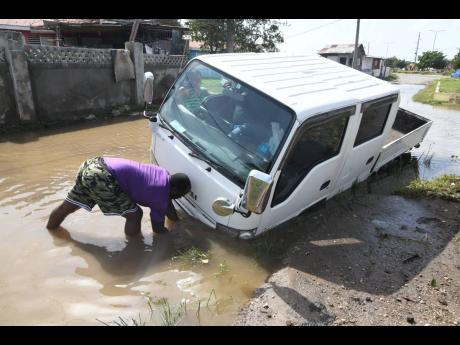Driving in the rain
Driving in Jamaica can become hazardous when the pavement is wet. Why? This is as a result of the friction between the tyres and the pavement becoming reduced. It means that the brakes may stop the wheels from rotating, but the motor vehicle will continue moving. It is like skating on a slippery surface. Apart from blurring the driver’s view of conditions ahead, rain can make a highway slippery, increasing stopping distances and the danger of skidding.
It is said that the first half-hour of the rainstorm is the most dangerous. During this period, the rainwater combines with the oil and rubber on the pavement surface, making a microscopic film rivalling ice for slipperiness. After approximately thirty minutes, the volume of water will wash the surface clean, and so cutting down but not eliminating the glaze.
Even after the pavement has been bathed almost clean, it will still remain more slippery than when dry. This is so because tyre adhesion has been cut, and handling will be affected. According to Alphonso Grennell, Grennell’s Driving School, this, coupled with the fact that less steering control is available on slippery surfaces, means that your motor vehicle will go out of control easier and will be more difficult to correct. All braking, steering, and acceleration must be done with finesse, in the rain. “Drivers should make a conscious effort towards smoothness in trying to avoid sudden changes of speed or direction.” says Shane Sutherland, guidance counsellor.
Motorists should ensure that their windshield wipers are in good condition. Nothing can place a more immediate handicap on a driver, in the rain, than a smeared water-streaked windshield. On slippery roads, it is best to drive slowly and stop and turn with care while keeping a safe distance behind other vehicles.
SLIPPERY ROADS
Bear in mind that any quick turn or change in speed can cause a skid. For control on slippery roads, steer straight as possible. Therefore your brakes should be adjusted so that they pull evenly.
If you drive through water puddles, test your brakes by pumping. This will also help dry them out. If the water is deeper than your tyre tread, slow down. This must also be done if your tyres make a slushing sound.
At speeds of 35mph, most tyres will contact wet road surfaces, much like a windshield wiper. As the speed increases, the tyres start to ride up on a film of water, which has an outcome similar to water skiing. This is called hydroplaning.
Here are some additional pointers for driving in the rain:
1. Know your road routes.
2. Beware the drizzle and slipperiness it brings.
3. Beware hydroplaning.
4. Watch out for camouflaged potholes.
5. Ensure that your car is properly equipped, especially with effective windshield wipers.
Lastly, don’t be afraid to wait out the rain.
Tips provided by Grennell’s Driving School. (876) 977-5249 (876) 228-0117, grennellsdriving@gmail.com




